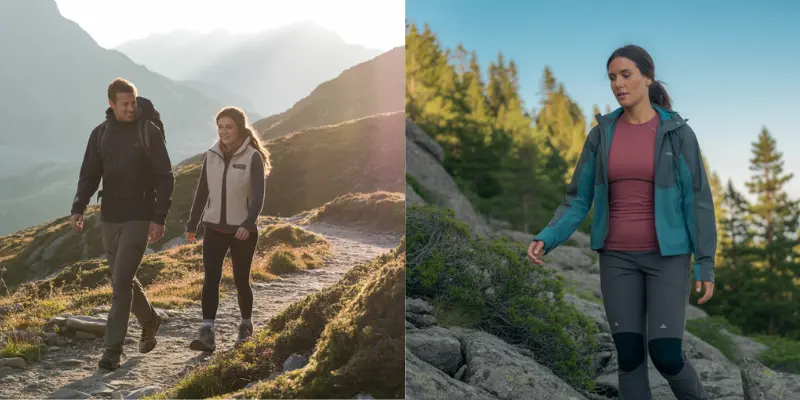What to Wear Hiking: Layer Guide for All Weather
Published: 5 May 2025
Planning what to wear hiking can make or break your adventure! The right clothes keep you comfy, safe, and ready for changing weather. No one wants soggy cotton shirts or blisters from bad shoes trust me! Whether it’s a sunny trail or a chilly mountain path, dressing smart means more fun and less fuss.
So, let’s keep it simple! What to wear hiking depends on weather, terrain, and how long you’ll be out. Think layers, quick-dry fabrics, and sturdy shoes. Ready to learn the easy way to pick your hiking outfit? Let’s go!
The Basics of Hiking Outfits

Getting your outfit right makes all the difference on the trail. The secret? Smart layering, choosing the right fabrics, and making sure everything fits properly. Nail these three things, and you’ll stay comfortable whether you’re sweating uphill or facing a surprise rain shower. Let’s break it down so you can hit the trails with confidence.
Layer Like a Pro
Layering is the ultimate trick for handling changing conditions. Start with a lightweight base that pulls sweat away from your skin. Throw on an insulating middle layer when temperatures drop, and top it off with a protective shell if the weather turns nasty. This system lets you adapt without carrying a whole wardrobe in your backpack.
- Start with a moisture-wicking shirt (synthetic or wool)
- Add a warm fleece or puffy jacket when needed
- Finish with a windproof/waterproof outer layer
Choose Your Fabrics Wisely
That comfy cotton tee? Leave it at home. Once cotton gets wet (from rain or sweat), it stays wet – leaving you cold and miserable. Instead, look for synthetic blends or merino wool that dry quickly and keep you comfortable. These materials breathe better and won’t weigh you down when damp.
- Best picks: polyester, nylon, merino wool
- Avoid: cotton, denim, heavy fabrics
- Look for: “quick-dry” or “moisture-wicking” labels
Get the Fit Just Right
Your hiking clothes should move with you, not against you. Aim for a close-but-comfy fit snug enough to avoid snagging on branches, but loose enough for full range of motion. Pay special attention to areas like shoulders and knees where you need the most flexibility.
- Look for: articulated knees, gusseted underarms
- Avoid: baggy pants that might trip you up
- Test it: do some deep squats and arm circles before buying
Remember: The right outfit keeps you focused on the adventure, not your clothes. Next, let’s talk about dressing for different weather conditions so you’re prepared for anything nature throws your way.
Essential Hiking Clothes: From Head to Toe
Picking the right clothes for your hike is like packing a toolkit; each piece has a specific job to keep you comfortable. Whether you’re tackling a sunny day trail or a chilly mountain path, having the right layers means you can focus on the adventure instead of fussing with your outfit. Let’s go through what really works, starting from top to bottom.
Top Half
Your upper body does most of the temperature regulation, so layering here is crucial. Start with a breathable base layer to wick away sweat, add insulation when it’s cold, and top it off with protection from wind or rain. This system works whether it’s 30°F or 70°F outside.
- Base: Lightweight, moisture-wicking tee or long sleeve
- Mid: Fleece jacket or thin puffer for warmth
- Outer: Packable windbreaker or rain shell
- Pro tip: Roll up sleeves or remove layers as you heat up
Bottom Half
Your legs need freedom to move and protection from brush and bugs. Quick-dry hiking pants are the most versatile, but shorts work for hot weather. When temperatures drop, thermal leggings under pants add warmth without bulk.
- Pants: Ripstop nylon with stretch (great for most conditions)
- Shorts: Best for warm, clear-weather hikes
- Leggings: Add under pants when it’s cold
- Watch out: Jeans get heavy when wet and restrict movement
Feet & Extremities
Nothing ruins a hike faster than blisters or cold toes. Wool or synthetic socks prevent rubbing, while proper footwear gives support on uneven terrain. Match your shoes to the trail rugged boots for rocky paths, lighter shoes for well-maintained trails.
- Socks: Merino wool or synthetic (never cotton)
- Boots: Ankle support for rough trails/heavy packs
- Trail shoes: Lighter option for day hikes
- Remember: Break in new footwear before long hikes
Weather-Specific Outfits
Mother Nature loves throwing curveballs, but with the right outfit, you’ll stay comfortable whether it’s blazing hot, freezing cold, or pouring rain. The trick is to tweak your layers and fabrics based on what the weather’s doing. Let’s break down exactly what works best for different conditions so you can hike in comfort no matter what.
Hot Weather Hiking
When the sun’s beating down, your clothes need to breathe while protecting you from UV rays. Light colors reflect heat, loose fits allow airflow, and moisture-wicking fabrics keep sweat from sticking to you. Don’t forget sun protection – your future self will thank you.
- Top: Lightweight, long-sleeve sun shirt (UPF rated)
- Bottom: Quick-dry hiking shorts or convertible pants
- Extras: Wide-brim hat, sunglasses, bandana for sweat
- Smart move: Wet your bandana and tie it around your neck
Cold Weather Hiking
Cold weather hiking is all about smart insulation. Start with a warm base layer, add insulating mid-layers, and finish with a windproof outer shell. Your extremities lose heat fastest, so protect your hands, head, and neck. Remember – it’s easier to remove layers if you get too warm than to magically produce them if you’re cold.
- Core: Merino wool base layer + fleece or puffy jacket
- Extremities: Gloves, beanie, neck gaiter
- Legs: Thermal leggings under weather-resistant pants
- Pro tip: Hand warmers in your pockets for breaks
Rainy Weather Hiking
Even the best rain gear might not keep you 100% dry in a downpour, but the right clothes will keep you comfortable. Waterproof outer layers are essential, but don’t forget about quick-drying layers underneath. Avoid overheating by choosing breathable rain gear when possible.
- Must-haves: Waterproof jacket (pit zips help vent heat)
- Bottom half: Quick-dry pants or rain pants over leggings
- Extras: Waterproof pack cover, dry bags for essentials
- Reality check: No gear is completely waterproof after hours in rain
The weather might be unpredictable, but your comfort doesn’t have to be. With these outfit strategies, you’ll be ready to hit the trail whether it’s sunny, snowy, or somewhere in between.
Extra Gear & Accessories
The right accessories can make or break your hike. They’re the finishing touches that keep you comfortable when the weather changes or the trail gets tough. Think of them like your hiking insurance policy – small items that solve big problems.
- Hat or cap: Wide-brim for sun protection, beanie for cold weather
- Sunglasses: UV-protective lenses to shield your eyes (polarized reduces glare)
- Backpack: 15-30L daypack with hip straps for carrying layers and supplies
- Bonus items: Buff neck gaiter (endless uses!), lightweight gloves, trekking poles
These small add-ons take up little space but make a huge difference in comfort. Toss them in your pack and you’ll be ready for whatever the trail throws at you!
What NOT to Wear Hiking
Some clothes might seem fine at the trailhead but will make you miserable by mile two. Heavy fabrics, poor footwear, and restrictive clothing can turn a fun hike into an uncomfortable slog. Here’s what to leave in your closet:
- Jeans: Absorb moisture and take forever to dry (hello, chafing!)
- Flip-flops/flimsy shoes: Zero support = sore feet and rolled ankles
- Cotton shirts/socks: Trap sweat and stay wet (recipe for blisters)
- Restrictive clothes: Tight jeans or non-stretchy fabrics limit movement
- Fashion sneakers: Lack grip and ankle support on uneven terrain
Remember: If it’s uncomfortable walking around town, it’ll be torture on the trail. Stick to technical fabrics and proper footwear your body will thank you!
FAQs
1. What clothes should you wear hiking?
Opt for moisture-wicking base layers, insulating mid-layers, and weather-resistant outerwear. Choose quick-dry fabrics like polyester or merino wool, and avoid cotton. Proper hiking shoes and wool socks keep your feet comfortable.
2. What is the 3-layer rule for hiking?
The 3-layer system includes a base layer (wicks sweat), a mid-layer (traps warmth), and an outer layer (blocks wind/rain). This setup lets you adjust to changing weather easily. Always pack layers you can remove them if you get too warm.
3. Is it better to hike in jeans or leggings?
Never hike in jeans; they absorb moisture, restrict movement, and take forever to dry. Leggings (especially moisture-wicking ones) are far better for comfort and flexibility. For rugged trails, choose durable hiking pants instead.
4. Do I need to wear a bra while hiking?
Yes, a supportive sports bra is key for comfort, especially on longer hikes. Look for moisture-wicking, breathable fabrics to prevent chafing. Avoid regular bras—they lack support and can cause discomfort.
5. Can I wear running shoes for hiking?
Running shoes work for short, well-maintained trails but lack ankle support and grip for rough terrain. For rocky or uneven paths, hiking shoes or boots are safer. Always choose footwear with good traction to prevent slips.
Conclusion
Now that you know what to wear hiking, you’re ready to hit the trails in comfort and style! Remember: layers are your best friend, moisture-wicking fabrics keep you dry, and proper footwear prevents blisters. Whether it’s a sunny day hike or a chilly mountain trek, dressing right makes all the difference.
So grab your gear, check the weather, and choose clothes that match your adventure. Most importantly? Have fun out there! The trails are waiting to enjoy them with confidence. Happy hiking!

- Be Respectful
- Stay Relevant
- Stay Positive
- True Feedback
- Encourage Discussion
- Avoid Spamming
- No Fake News
- Don't Copy-Paste
- No Personal Attacks

- Be Respectful
- Stay Relevant
- Stay Positive
- True Feedback
- Encourage Discussion
- Avoid Spamming
- No Fake News
- Don't Copy-Paste
- No Personal Attacks






